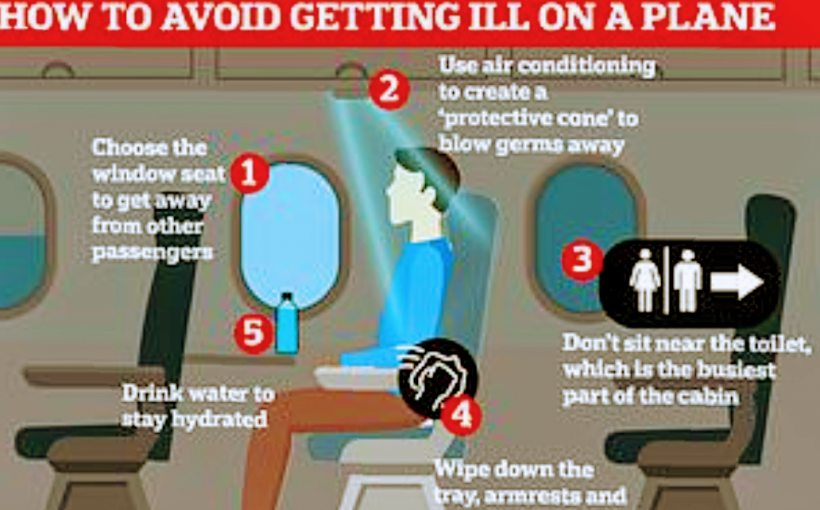Among the souvenirs holidaymakers bring back, perhaps the most unwelcome is the cold or flu caught on the plane that flew them there. Hundreds of people spending hours in a sealed container coughing, spluttering and breathing on one another is likely a breeding frenzy for bacteria and viruses.
But there are things you can do to reduce your risk of catching an illness from the personal space violator beside you. Sitting in a window seat away from the toilet, using the air con, drinking lots of water and wiping down the trays and armrests are the top tips revealed by the English Institute of Sport.
The sporting body issued the advice for athletes who will be flying to Tokyo for the Olympics next year, but you don’t have to be a sprinter to benefit from its lessons. Viruses spread on jets because of low humidity and air conditioning. The institute suggests sitting by a window to reduce contact with people in the aisle.
Passengers should also adjust their air conditioning to create a ‘cone of protection’, and clean armrests with disinfectant spray. Dr Craig Ranson, its director of athlete health, said the biggest danger was respiratory illness – bugs which infect the lungs.
He added: ‘We are giving guidance about how athletes can clean their seat and where to sit so the air conditioning leaves them less exposed to bugs from other people in the plane.
‘We ran an illness prevention campaign last year, too, and whether it was a direct result or not we had 40 per cent less illnesses last January than previously. Illnesses which commonly spread among people kept in close quarters include colds, flu, chest infections and sickness bugs like norovirus.
These are mostly spread in droplets of people’s breath, which are expelled into the air around them when they cough or sneeze, and can survive on people’s hands or on hard surfaces which are later touched by someone else. There is science to back up the fear that people are more likely to get ill in the air.
A study by the University of Victoria in Canada surveyed 1,100 people who had flown between San Francisco and Denver, and compared them with 131 commuters in London. The research found ‘the flight cold transmission rate would appear to be some 23 times that normally experienced by ground level adult commuters’.
The Victoria researchers said people inside a cabin would face higher concentrations of viruses because there was less fresh air circulating than outside. The EIS’s Dr Ranson added: ‘There are some things you wouldn’t necessarily think about but are actually quite simple and can have a big difference,’ The Times reported.
‘We are giving guidance about how the athletes can clean their seat in the plane and where to sit in the plane so the air conditioning leaves them less exposed to bugs from other people in the plane. We advise athletes not to sit near the toilets.
‘Respiratory illness is by far the biggest health issue that causes time away from preparation and performance so we looked at what can we do to tackle this burden systematically.’ The institute’s advice comes after supermodel Naomi Campbell tweeted a photo of herself wearing a surgical mask, rubber gloves and carrying Dettol wipes on a flight in July.
She captioned the picture ‘fly safe’ and revealed she always cleans everything before touching it when she’s on board a plane.
‘No matter what plane you take, private or commercial, people start coughing and sneezing and it makes me . . . I just can’t,’ she said. Concerns her routine was over-the-top were compounded by experts who said simply keeping your hands clean should be enough, and that air in planes is pushed through filters which ‘effectively remove dust, vapors, bacteria, fungi and the droplets via which most viruses are spread’.
But Dr Nathan Favini of Forward Health said: ‘Respiratory viruses are the most common cause of illness while traveling and are transmitted through the air. ‘It’s a good idea to carry a mask to protect yourself if you sit near someone who has symptoms of a respiratory infection.’
Dailymail


